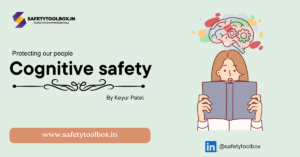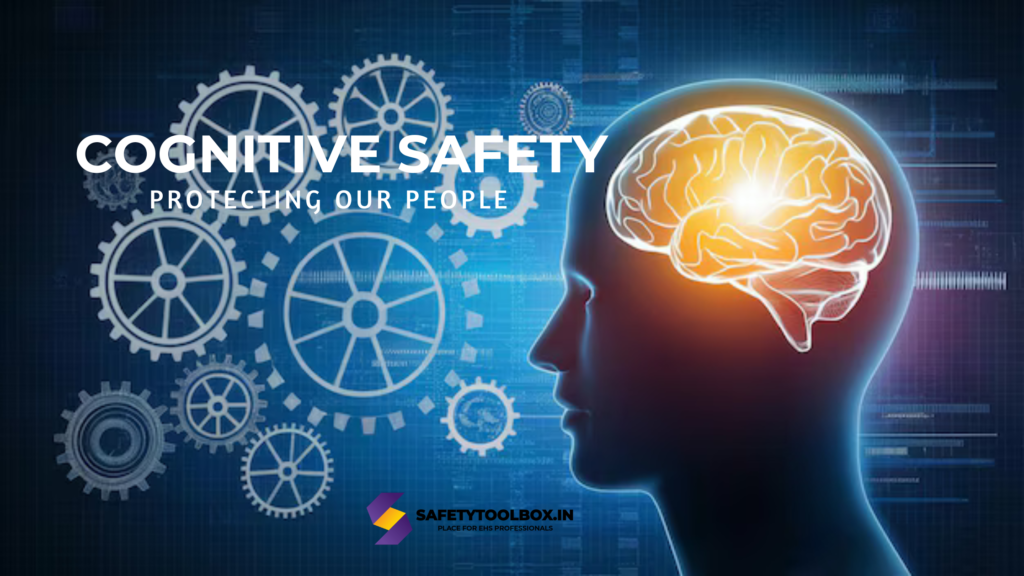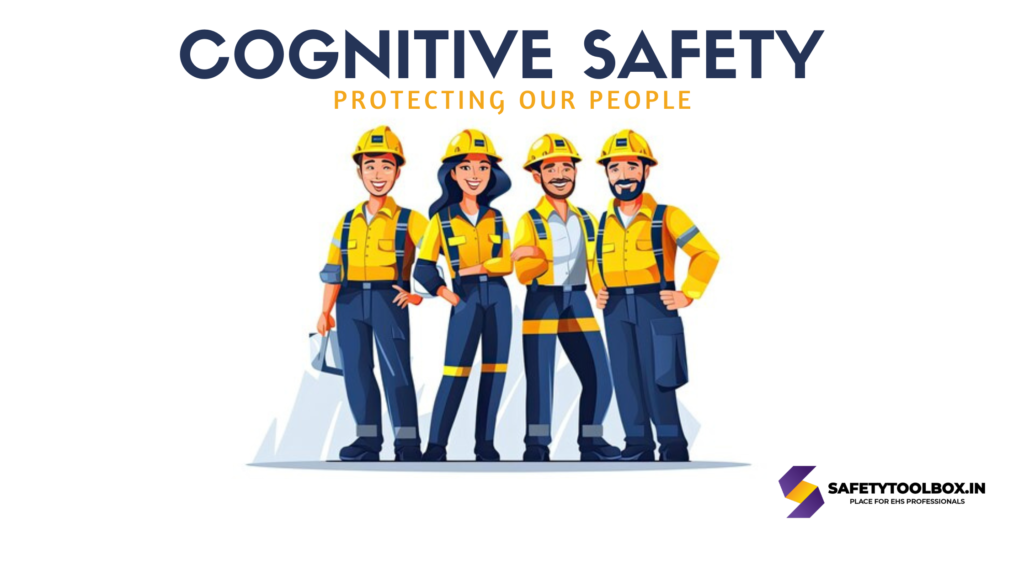Cognitive Safety in Process Operations: A Crucial Focus for Today’s and Tomorrow’s Workforce this article helps to learn about the cognitive safety
Table of Contents
Introduction to Cognitive Safety
As our workplaces evolve with advanced technologies and increasing complexities, ensuring worker safety extends beyond physical hazards. Cognitive safety—protecting employees from mental overload, stress, and distractions—has become a crucial focus in industries today. By prioritizing cognitive safety, organizations can foster a culture of safety that is essential for today’s fast-paced environments.
The Growing Need for Cognitive Safety
In the modern workplace, operators and technicians are often required to process vast amounts of information while making quick decisions. A study by the National Safety Council (NSC) found that 90% of workplace accidents are caused by human error, with cognitive overload being a major contributing factor. Additionally, it is estimated that 43% of workers are mentally distracted during their shifts, which not only increases the risk of mistakes but also reduces productivity.
Understanding Cognitive Overload
Cognitive overload occurs when individuals are required to process more information than they can handle. This can result in missed warnings and critical errors
Historical Lessons: Learning from Past Incidents
Historical incidents highlight the importance of addressing cognitive overload. For example, the BP Texas City Refinery explosion in 2005 was partially attributed to operator fatigue and cognitive errors. Workers failed to recognize key warning signs in the lead-up to the explosion, partly due to overburdened control systems and mental strain. This incident resulted in 15 deaths and over 180 injuries, demonstrating the severe consequences of cognitive failure.
Events like the Three Mile Island nuclear accident in 1979, where operators were distracted by alarms and failed to respond appropriately, underline the catastrophic effects of cognitive overload. These historical lessons demonstrate that addressing cognitive challenges is vital for preventing future tragedies.
Identifying Key Risks
The future generation of workers will face even more challenges as automation, artificial intelligence (AI), and data analytics reshape industries. However, human oversight and decision-making will remain critical, making cognitive safety a necessity.
The Risks: Cognitive Overload, Fatigue, and Distraction
1. Information Overload:
Operators are often bombarded with data, alarms, and tasks that require their attention. When faced with an overwhelming amount of information, their ability to focus diminishes, and errors become more likely. Studies indicate that multitasking can cut productivity by up to 40%, highlighting the need for streamlined information flow.
2. Fatigue and Stress:
Long work hours, lack of sleep, and high-pressure environments are common in many industries. Fatigue impairs cognitive functions such as memory, attention, and decision-making, leading to mistakes. For example, a study by the American Society of Safety Professionals (ASSP) found that fatigued workers are 70% more likely to be involved in accidents than well-rested individuals. The Exxon Valdez oil spill of 1989 is a classic example where crew fatigue was cited as a significant factor in the catastrophic event. The crew, working long hours with little rest, made critical navigation errors that led to one of the worst environmental disasters in history.
3. Distractions in the Workplace:
Common distractions, such as the use of mobile phones, and background noise, are becoming more prevalent. In fact, research suggests that 57% of workers admit to using their mobile phones while working, which can lead to critical errors. For instance, an operator checking messages during a complex task may miss an alarm or an important system change, potentially leading to a dangerous situation.
Why Cognitive Safety is Essential for Future Workforces
As industrial processes become more digital and interconnected, workers will face even more mental demands. The future workforce will need to navigate AI-powered systems, monitor real-time data streams, and manage tasks with heightened complexity. Cognitive safety is the bridge that can help operators remain sharp and focused while reducing the risk of human error.
Investing in cognitive safety strategies is not just a matter of protecting workers today; it’s about building resilient work environments that can handle tomorrow’s challenges.
Here’s why cognitive safety matters for the future:
Human-Machine Collaboration:
As AI and automation become more integrated, humans will be responsible for overseeing these technologies. Mistakes in judgment or miscommunication between humans and machines can lead to significant safety risks.
Sustainability of Operations:
Efficient, error-free processes are key to maintaining long-term operational success. Fewer mistakes mean fewer incidents and downtime, leading to higher profitability and sustainability.
Mental Well-being of Workers:
Cognitive safety also contributes to the mental health and well-being of employees. Stress, fatigue, and overload are not just operational risks—they also lead to burnout and long-term mental health issues, which can result in higher turnover and absenteeism.
Effective Strategies to Enhance Cognitive Safety
1. Designing Ergonomic Workspaces
Work environments should be designed to minimize cognitive strain. Control rooms, for instance, should present data in a clear, structured way, reducing unnecessary information clutter. Ergonomically designed workstations, with intuitive control panels and easy-to-read displays, can significantly enhance operator focus.
2. Automation and Decision Support Systems
While automation helps reduce cognitive load, decision support systems (DSS) can further assist operators by providing real-time insights and flagging anomalies. For example, AI-powered tools can identify early warning signs of equipment failure, allowing workers to focus on critical tasks without becoming overwhelmed by routine monitoring.
3. Regular Training and Simulations
Regular training, especially through simulation exercises, can significantly reduce cognitive errors. By practicing in high-pressure, realistic scenarios, workers can improve their decision-making skills and response times. For instance, operators trained in handling emergency scenarios through simulations are 50% more likely to make correct decisions under pressure compared to those who are only trained theoretically.
4. Shift Management and Workload Distribution
Effective management of workloads and shift schedules can help reduce fatigue. Studies show that performance declines sharply after 9 hours of continuous work, so companies should structure shifts to ensure that operators have enough rest between working hours. Additionally, monitoring workloads in real-time and redistributing tasks as needed can help prevent burnout.
5. Implementing Cognitive Aids
Checklists, visual guides, and reminders are simple but powerful tools that help workers avoid forgetting important steps in a process. For example, using digital checklists that prompt operators to confirm the completion of tasks can prevent skipped steps, especially in high-risk processes.
6. Monitoring for Cognitive Fatigue
Fatigue-monitoring systems are increasingly being used to detect early signs of cognitive strain. Wearable devices can monitor workers’ alertness levels and notify supervisors if an operator is at risk of cognitive overload or fatigue. This proactive approach allows companies to intervene before an accident occurs.
Realistic Examples of Cognitive Safety in Action
One common issue that affects cognitive safety is the use of mobile phones during operations. Imagine a worker at a chemical plant who needs to monitor several screens to ensure the system is functioning properly. If they are distracted by a text message and fail to notice a warning light, it could lead to equipment failure, causing both safety and financial losses. Similarly, in construction, workers checking their phones while operating machinery could result in severe accidents or injuries.
A real-world example comes from the aviation industry, where cognitive safety has become a priority. Pilots are trained extensively in simulators to handle high-pressure scenarios such as engine failures or bad weather. The cockpit’s design also aids cognitive safety by simplifying controls and using clear alarms to indicate problems, reducing cognitive strain during critical moments. This approach has helped make aviation one of the safest industries despite its high complexity.
Conclusion:
Cognitive safety is not a concept of the future; it is a necessity for the present. As workplaces become more complex and interconnected, the mental demands placed on workers will continue to rise. Investing in cognitive safety today ensures that operators remain focused, alert, and capable of making accurate decisions, even in high-pressure environments.
For future generations, embracing cognitive safety is crucial to coping with the challenges posed by digitalization, automation, and ever-increasing operational complexity. From minimizing distractions like mobile phone use to optimizing workspaces and leveraging technology to reduce mental strain, companies can take meaningful steps to safeguard their workers’ cognitive health.
Ultimately, cognitive safety isn’t just about preventing accidents, it’s about building smarter, safer, and more efficient workplaces—both for today’s workforce and for generations to come.
For regular updates on safety topics or videos follow us on LinkedIn
for more safety toolbox talk click here…



Very nicely explained Dear Keyur. Cognitive safety is proactively taking care of the mental well-being of the employees. This is the need of present as we are faced with numerous challenges including flow of multiple information to mind through various channels and our mind has to process all. Keep sharing for our learning. Thank you and very well done.
Thank you sir,for a valuable feedback